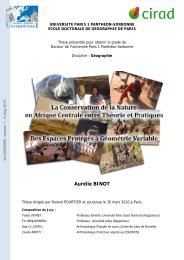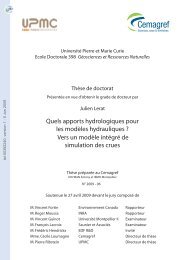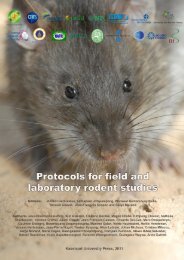Partie C : Résultats – Chapitre C-IOther studies have shown that earthworms can influence the metal availability in soil bymixing <strong>de</strong>ep soils; humus and biological material in the earthworm gut (29). Furthermore,lead has been shown to have low mobility in soil (<strong>les</strong>s than Cd and Zn) and to form organiccomplexes which make it unavailable for plants (30). Ma et al. (17) <strong>de</strong>monstrated that theconcentration of available Pb was increased by up to 48.2% by earthworm inoculation andChen (31) suggested that earthworm burrowing and feeding activities increased metalbioavailability.tel-00486649, <strong>ver</strong>sion 1 - 26 May 2010In conclusion, Lantana camara proved its capacity to grow well in soil contaminatedwith a high lead concentration. Efficient phytoextraction needs hyperextracting plants toremove heavy metals from polluted soils but also a high shoot-to-root for accumulatingmetals in the harvestable parts (32). The remediation efficiency also <strong>de</strong>pends on the amountof aboveground biomass and the bioavailability of metals (33). This study shows that P.corethrurus earthworms <strong>sur</strong>vived in lead polluted soils and that their activities improved plantgrowth and phytoextraction of Pb. They also had a positive effect on the root biomass and TF.These results clearly <strong>de</strong>monstrate that the association of P. corethrurus and L. camara hasconsi<strong>de</strong>rable potential as an efficient lead phytoextractor. Studies are now being carried out togain a better un<strong>de</strong>rstanding of the relationships between plant and earthworm and improvetheir remediation efficiency.AcknowledgementsThis work was fun<strong>de</strong>d by IRD, Institut <strong>de</strong> Recherche pour le Développement in France.We should like to thank Mrs. DIEP My-Hanh (Phu An Bamboo Village, Binh DuongProvince, Vietnam) for helping during our experiments and providing the Lantana camaraplants. Our thanks also go to the Uni<strong>ver</strong>sity of Agriculture and Forestry of Ho Chi Minh Cityin Vietnam for chemical and physical analysis.63
Partie C : Résultats – Chapitre C-Itel-00486649, <strong>ver</strong>sion 1 - 26 May 2010References(1) A.S. Sheoran, V. Sheoran, Heavy metal removal mechanism of acid mine drainage inwetlands: A critical review. Minerals Engineering 19 (2006) 105-116.(2) D.B. Johnson, K.B. Halberg, Acid mine drainage remediation options: a review. Scienceof the Total Environment 338 (2005) 3-14.(3) K. Shah, J.M. Nongkynrih, Metal hyperaccumulation and bioremediation. BiologiaPlantarum 51 (2007) 618-634.(4) S.P. McGrath, Phytoextraction for soil remediation. In R.R. Brooks (ed.) Plants thathyperaccumulate heavy metals.CAB Int., Wallingford, UK, 1998, pp. 261-287.(5) D.J. Glass, Economic potential of phytoremediation. In Raskin I. and Ensley B.D. (ed.).Phytoremediation of toxic metals. John Wiley and Son, New York, 2000, pp.15-31.(6) Y. Ma, M. Rajkumar, H. Freitas, Inoculation of plant growth promoting bacteriumAchromobacter xylosoxidans strain Ax10 for the improvement of copper phytoextraction byBrassica juncea. Journal of Environmental Management 90 (2009) 831-837.(7) A.C. Monstant, C. Tang, A.J.M. Baker, The effect of nitrogen form on rhizosphere soil pHand zinc phytoextraction by Thlaspi caeru<strong>les</strong>cens. Chemosphere 73 (2008) 635-642.(8) A. Braud, K. Jézéquel, S. Bazot T. Lebeau, Enhanced phytoextraction of an agriculturalCr- and Pb- contaminated soil by bioaugmentation with si<strong>de</strong>rophore-producing bacteria.Chemosphere 74 (2009) 280-286.(9) E.T. Pawlowska, L.R. Chaney, M. Chin, I. Charvat, Effects of metal phytoextractionpractices on the Indigenous community of arbuscular mycorrhizal fungi at a metalcontaminated landfill. Applied and Environmental Microbiology (2000) 2526-2530.(10) A. Kayser, K. Wenger, A. Keller, W. Attinger, W. Felix, S.K. Gupta, R. Schulin,Enhancement of phytoextraction of Zn, Cd and Cu from calcareous soil: the use of NTA andsulfur amendments. Environmental Science and Technology 34 (2000) 1778-1783.(11) N. Finzgar, D. Lestan, The two-phase leaching of Pb, Zn and Cd contaminated soil usingEDTA and electrochemical treatment of the washing solution. Chemosphere 73 (2008) 1484-1491.(12) G.G. Brown, C.A. Edwards, L. Brussaard, How earthworm affect plant growth:burrowing into the mechanisms. In: Edwards, C.A. (Ed.), Earthworm Ecology. CRC Press,Boca Raton, USA, 2004, pp.13-49.(13) S. Scheu, Effects of earthworms on plant growth: patterns and perspectives. Pedobiologia47 (2003) 846–856.64
- Page 7 and 8:
tel-00486649, version 1 - 26 May 20
- Page 9 and 10:
4. Discussion…………………
- Page 13 and 14:
Introduction généraledifférentes
- Page 15 and 16:
Partie A : Synthèse bibliographiqu
- Page 20 and 21:
Partie A : Synthèse bibliographiqu
- Page 23 and 24:
Partie A : Synthèse bibliographiqu
- Page 25 and 26: Partie A : Synthèse bibliographiqu
- Page 27 and 28: Partie A : Synthèse bibliographiqu
- Page 29 and 30: Partie A : Synthèse bibliographiqu
- Page 31 and 32: Partie A : Synthèse bibliographiqu
- Page 33 and 34: Partie A : Synthèse bibliographiqu
- Page 35 and 36: Partie A : Synthèse bibliographiqu
- Page 37 and 38: Partie A : Synthèse bibliographiqu
- Page 39 and 40: Partie A : Synthèse bibliographiqu
- Page 41 and 42: Partie B : Matériel et MéthodesI/
- Page 43 and 44: Partie B : Matériel et MéthodesPo
- Page 45 and 46: Partie B : Matériel et MéthodesII
- Page 47 and 48: Partie B : Matériel et MéthodesPo
- Page 49 and 50: Partie B : Matériel et MéthodesFi
- Page 51 and 52: Partie B : Matériel et MéthodesV/
- Page 53 and 54: Partie B : Matériel et MéthodesV.
- Page 55 and 56: Partie B : Matériel et Méthodessp
- Page 57 and 58: Partie B : Matériel et MéthodesL
- Page 59 and 60: Partie B : Matériel et MéthodesCo
- Page 61 and 62: Partie C : Résultatstel-00486649,
- Page 63 and 64: Partie C : Résultats - Chapitre C-
- Page 65 and 66: Partie C : Résultats - Chapitre C-
- Page 67 and 68: iomasse sec (g)Partie C : Résultat
- Page 69 and 70: Partie C : Résultats - Chapitre C-
- Page 71 and 72: Partie C : Résultats - Chapitre C-
- Page 73 and 74: Partie C : Résultats - Chapitre C-
- Page 75: Partie C : Résultats - Chapitre C-
- Page 79 and 80: Partie C : Résultats - Chapitre C-
- Page 81 and 82: Partie C : Résultats - Chapitre C-
- Page 83 and 84: Partie C : Résultats - Chapitre C-
- Page 85 and 86: Partie C : Résultats - Chapitre C-
- Page 87 and 88: Partie C : Résultats - Chapitre C-
- Page 89 and 90: Partie C : Résultats - Chapitre C-
- Page 91 and 92: Partie C : Résultats - Chapitre C-
- Page 93 and 94: Partie C : Résultats - Chapitre C-
- Page 95 and 96: Partie C : Résultats - Chapitre C-
- Page 97 and 98: Activité enzymatiqueActivité enzy
- Page 99 and 100: Partie C : Résultats - Chapitre C-
- Page 101 and 102: Partie C : Résultats - Chapitre C-
- Page 103 and 104: Partie C : Résultats - Chapitre C-
- Page 105 and 106: AgV/T/SVS /T/SVAgP/T/SPS/T/SPAgP/T/
- Page 107 and 108: Partie C : Résultats - Chapitre C-
- Page 109 and 110: AgPTSP1AgPTSP2AgPTSP3AgPTSPV1AgPTSP
- Page 111 and 112: AWCDPartie C : Résultats - Chapitr
- Page 113 and 114: Partie C : Résultats - Chapitre C-
- Page 115 and 116: Partie C : Résultats - Chapitre C-
- Page 117 and 118: Partie C : Résultats - Chapitre C-
- Page 119 and 120: Nombre morphologiePartie C : Résul
- Page 121 and 122: Partie C : Résultats - Chapitre C-
- Page 123 and 124: Partie C : Résultats - Chapitre C-
- Page 125 and 126: Partie C : Résultats - Chapitre C-
- Page 127 and 128:
Partie C : Résultats - Chapitre C-
- Page 129 and 130:
Partie C : Résultats - Chapitre C-
- Page 131 and 132:
Partie D : Discussion - Conclusion
- Page 133 and 134:
Partie D : Discussion - Conclusion
- Page 135 and 136:
Partie D : Discussion - Conclusion
- Page 137 and 138:
RéférencesAAbbass, M.I. and Razak
- Page 139 and 140:
Référencestel-00486649, version 1
- Page 141 and 142:
Référencestel-00486649, version 1
- Page 143 and 144:
Référencestel-00486649, version 1
- Page 145 and 146:
RéférencesGregory, P.J. (2006). R
- Page 147 and 148:
RéférencesJiménez, J.J., Cepeda,
- Page 149 and 150:
RéférencesKuperman, R.G., Carreir
- Page 151 and 152:
RéférencesLoué, A. (1993). Oligo
- Page 153 and 154:
RéférencesNNaidu, R., Bolan, N.S.
- Page 155 and 156:
Référencestel-00486649, version 1
- Page 157 and 158:
Référencestel-00486649, version 1
- Page 159 and 160:
RéférencesTorsvik, V., and Øvra
- Page 161 and 162:
tel-00486649, version 1 - 26 May 20
- Page 163 and 164:
Annexe 2 : Liste de morphologies fo
- Page 165 and 166:
tel-00486649, version 1 - 26 May 20
- Page 167 and 168:
tel-00486649, version 1 - 26 May 20
- Page 169:
SUMMARYtel-00486649, version 1 - 26
















